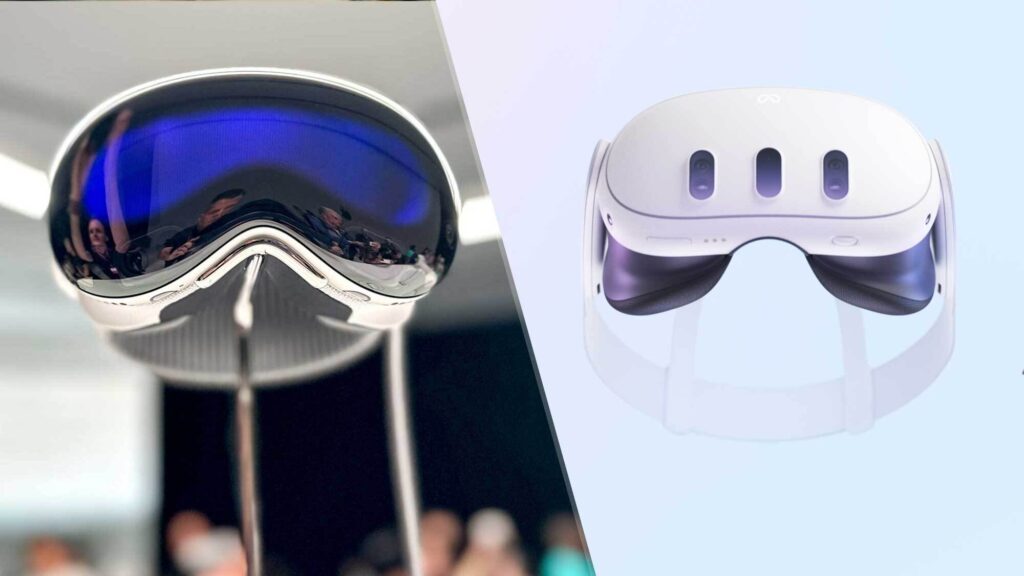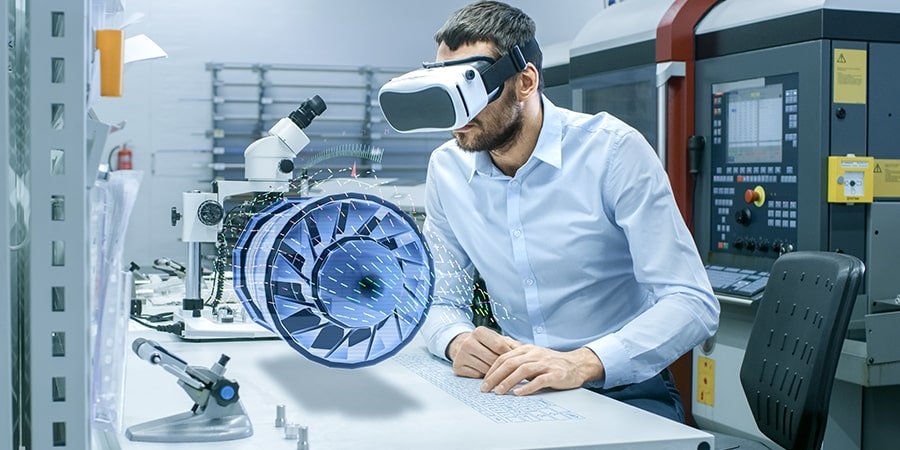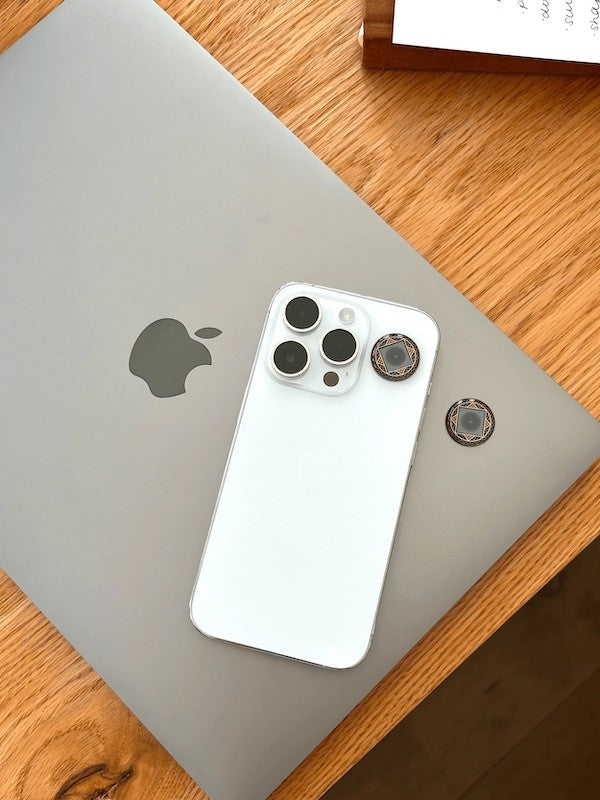
Apple Vision Pro: A New Frontier for Mixed Reality
Table of Contents
Apple’s long-awaited move into the headset game has arrived this February of 2024. The vision that Apple is offering is a redefining of the mixed reality (MR) headset technology sector, and an expansion of what these technologies offer humanity.
In this article, we will explore how Apple’s Vision Pro fits into this blossoming field of technology and how it represents a massive change from simple entertainment toward deeper technological integration.
Passthrough Technology in Mixed Reality Headsets
What is Passthrough Technology?
Passthrough technology headsets are a relatively new form of mixed reality tech that is positioned to become the industry standard over the next few years. The users of these headsets can essentially “see” their surroundings via a digital representation that is provided by various sensors and cameras. This is a significant leap from the virtual reality (VR) that society has largely been exposed to since the release of these video headsets, where one would be completely immersed in the video feed of whatever program was being run. This is also different from augmented reality (AR) where a display is overlayed onto a transparent lens because what the user is viewing is still completely virtual space.
What the Vision Pro Represents

Apple is leading the way in this field as the Vision Pro is centered around this new format of mixed reality, whereas other products like the Meta Quest 3 have updated their technology from solely VR to offer a similar passthrough experience. This technology represents a more seamless integration of the real world and virtual world and points to the potential beyond just video games into productivity and other more practical applications.
The release of the Vision Pro opens the gates to a new world of tech-enabled productivity and content consumption beyond anything humanity has been exposed to thus far.
Potential Applications for this New Technology
Beyond the hype surrounding its initial release, the utilization of passthrough technology raises intriguing possibilities for clinical and industrial applications.
Clinical Applications
Researchers have speculated on the potential for this new technology to help people with vision impairments, emphasizing the headset’s ability to display the entire depth range of the real world on the same focal plane.
What this means is that headsets with mixed reality technology could, in theory, replace traditional corrective eyewear. This could prove particularly useful for individuals struggling with focusing on nearby objects, such as those with presbyopia.
If proven effective, the Apple Vision Pro could offer a dynamic and technologically advanced alternative to conventional corrective lenses, marking a significant leap forward in the intersection of augmented reality and healthcare.
Industrial Applications
Imagine technicians having the ability to overlay critical information onto their real-world field of view, facilitating streamlined maintenance and repair processes. The hands-free operation, coupled with enhanced visualization, could prove invaluable in complex tasks, from equipment diagnostics to intricate assembly processes.

The Vision Pro not only offers mixed reality experiences for consumers but also hints at a future where technology seamlessly integrates into the fabric of industrial operations, enhancing efficiency and productivity in unprecedented ways.
This new tech invites us to envision a future where the real world can be merged with immersive digital experiences in a way that changes how we engage with the visual world.
A New Need for Responsible Development in the MR Industry
As the industry continues to rapidly break ground on how people engage with technology, it becomes increasingly important for the pioneering companies, namely Meta and Apple, to acknowledge the critical importance of responsible development.
It’s an incredibly human flaw to get so caught up in the potential technological advancements that we overlook major downstream effects on society. If we are to learn from the mistakes of our past, we would do well to tread carefully as we venture into this new world.
As the capabilities of mixed reality technologies expand, so does the ethical responsibility to ensure that these advancements are deployed with careful consideration for user safety, privacy, and societal implications.
Apple’s Vision Pro represents a foundational shift into a new chapter of digitally integrated reality. Only time will tell whether this will be a net positive or negative for society at large.
Apple’s Approach to Ensuring Safety and Responsible Usage
Apple does serve to be a notable example of a company taking a proactive stance on responsible MR development. Recognizing the transformative power of augmented reality (AR) and virtual reality (VR), Apple has consistently emphasized the importance of user safety. The company has integrated robust safety features into its MR devices and platforms, setting a standard for responsible usage within the industry.
Academics Calling for Caution
Several academics and studies in emerging technologies have underscored the importance of caution around these new technologies.
“Given how far headsets with passthrough video have come, it’s time to dedicate serious academic thought to the psychological and behavioral effects of this technology,”
Jeremy Bailenson, the Thomas More Storke Professor in the Stanford School of Humanities and Sciences and founding director of the Virtual Human Interaction Lab (VHIL)
This peer-reviewed journal article from the Stanford Virtual Human Interaction Lab (VHIL) has been one of the more significant calls for caution in this emerging field.
“For example, there are likely to be developmental issues. According to a 2021 survey, 17 percent of children between the ages of 8 and 18 own a VR headset (Reed & Joseff, 2022) and about one in twenty-five child users are donning headsets every day (Piper Sandler, 2023). While scholars have previously examined developmental issues surrounding MR headset use in children (Bailey & Bailenson, 2017; Pimentel, D., & Kalyanaraman, 2022), to our knowledge there is no research on children’s use of passthrough. Meta has recently reduced their minimum age requirements to 10 years old, down from 13.
Psychological Implications of Passthrough Video Usage in Mixed Reality
Apple is explicitly advertising that people can use their headsets “all day long,” and their safety guidelines will remain unknown until the official release of the headset. Meta has clear and useful health and safety guidelines, but they are designed for problems which might occur during use. In other words, they offer specific strategies to avoid collisions and manage simulator sickness, but do not offer insights regarding long-term passthrough usage. Even the safety guidelines encourage extended use, urging users to start with thirty-minute sessions, but then to “increase the amount of time using your Meta Quest gradually as you grow accustomed to the experience.” Although Meta acknowledges the distortions in color and space perception in passthrough mode (Meta, 2023a), it is unclear how a consumer should take action on this advice.”
As pioneers in the MR industry continue to innovate, they must do so with a keen awareness of their responsibility to society. By prioritizing safety, privacy, and ethical considerations, these companies can contribute to the sustainable and positive growth of the mixed reality landscape.
EMF Risks of Apple Vision Pro
Amidst the social and psychological challenges that these new headset technologies present us with, there is also a huge potential for adverse health effects due to EMF (electromagnetic frequency) exposure.
All electronic devices create invisible frequencies that in turn generate radiation which has been correlated to health issues like impaired sleep, decreased fertility in both men and women, and even cancer.
The biggest factors in biological dysregulation due to EMFs are intensity, proximity, and concentration of exposure (time of exposure and accumulation of multiple sources). The research we do have on EMFs has not considered the potential implications of having a very powerful device strapped to one’s head for several hours a day, particularly not one that uses cellular, Wi-Fi, and Bluetooth signals to connect to the internet and other various devices.
Users have even reported sleeping with the Apple Vision Pro.
Using Aires Tech to Safeguard Oneself From Excessive EMF Exposure

Aires Tech offers the most comprehensive solution on the market to protect people from excessive EMF exposure. We offer the only technology that has been rigorously tested and validated by third-party studies to have proven efficacy in reducing the negative effects of EMF exposure.
Adding a Lifetune One to your Apple Vision Pro, for example, could greatly reduce the potential dysregulation caused by having such a powerful device strapped centimeters away from your brain.
Our products are frequently reported to help people sleep, experience less inflammation, and reduce overall psychological and physiological stress.
Final Thoughts as We Move Forward
All we really know at this point is how little we know. The potential implications of these technologies are undeniably massive and could change the way we engage with technology and digital information completely.
It will likely take a while for the true impact of mixed-reality headsets to take effect. Similar to the unveiling of large language model systems like chat GPT or even the Apple iPhone, the technology is a bit clunky and awkward presently, but the interesting thing that we can infer from these past innovations is the way they have grown to shift the structure of our modern society.
Hopefully, the intimacy and depth of human integration with these devices will spur a reconsideration of the standards that tech companies hold themselves and others to.
Digital technology surely isn’t going anywhere anytime soon, so it does little good to simply ignore the looming implications of these devices, we should instead turn toward them as a collective so that we can use them responsibly, ethically, and above all in a way that is healthy and productive for society as a whole.
In an era marked by rapid evolution, one thing is clear: we are living through uniquely fascinating times.




